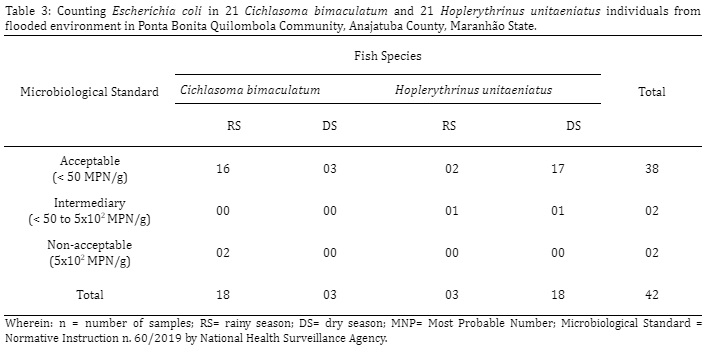Microbiological featuring of two neotropical fish species from the quilombola area of Maranhão state, Brazil
DOI:
https://doi.org/10.21708/avb.2023.17.1.11423Keywords:
Traditional communities; fish; microbiology; indicator microorganisms.Abstract
The aim of study is to feature the microbiological quality of two neotropical fish species from the quilombola area of Maranhão State, Brazil. In order to do so, 21 samples of Hoplerythrinus unitaeniatus and 21 samples of Cichlasoma bimaculatum were captured in flooded environment. Collected fish were euthanized in laboratory environment; muscle fragments were removed for microbiological analyses focused on enumerating molds and yeasts, viable strict and facultative mesophilic microorganisms and coagulase-positive staphylococci; on counting total and thermotolerant coliforms; and on investigating Escherichia coli and Salmonella sp. Microbiological results were compared to the Brazilian legislation, which establishes the list of microbiological standards for food products. Among the assessed fish, 9.52% were classified as non-acceptable for human consumption, based on the Salmonella parameter. Enumerated coagulase-positive staphylococci ranged from < 10 to 3.9 x 104 CFU/g; 9.52% of assessed fish were classified as having intermediate standard for human consumption, whereas 4.76% were classified as non-acceptable for such a purpose. E. coli counting ranged from 3.6 to > 1,100MPN/g; 4.76% of assessed fish were classified as having intermediate standard for human consumption, whereas 4.76% were classified as non-acceptable for such a purpose. Total and thermotolerant coliforms’ counting and the enumeration of viable strict and facultative aerobic microorganisms, as well as of molds and yeasts, have evidenced high microbial population rates; this finding suggests poor hygienic conditions at capture site, contaminated raw material and risk of incidence of enteropathogens. This finding has evidenced imbalance in the investigated environment, as well as compromised aquatic biodiversity.
Downloads

Downloads
Published
Issue
Section
License
Copyright (c) 2023 Acta Veterinaria Brasilica

This work is licensed under a Creative Commons Attribution 4.0 International License.
Autores que publicam na Acta Veterinaria Brasilica concordam com os seguintes termos: a) Autores mantém os direitos autorais e concedem à revista o direito de primeira publicação, com o trabalho simultaneamente licenciado sob a Licença Creative Commons Attribution que permite o compartilhamento do trabalho com reconhecimento da autoria e publicação inicial nesta revista. b) Autores têm autorização para assumir contratos adicionais separadamente, para distribuição não-exclusiva da versão do trabalho publicada nesta revista (ex.: publicar em repositório institucional ou como capítulo de livro), com reconhecimento de autoria e publicação inicial nesta revista. c) Autores têm permissão e são estimulados a publicar e distribuir seu trabalho online (ex.: em repositórios institucionais ou na sua página pessoal) a qualquer ponto antes ou durante o processo editorial, já que isso pode gerar alterações produtivas, bem como aumentar o impacto e a citação do trabalho publicado (Veja O Efeito do Acesso Livre).


 Esta obra está licenciada com uma Licença
Esta obra está licenciada com uma Licença 